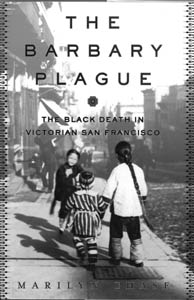![[Metroactive Books]](/books/gifs/books468.gif)
[ Books Index | Silicon Valley | Metroactive Home | Archives ]
|
Buy
'The Barbary Plague: The Black Death in Victorian San Francisco' by Marilyn Chase.
|

Plague Journal Marilyn Chase's 'Barbary Plague' chronicles a health scare with modern echoes By Michael S. Gant WHAT WITH the recent severe acute respiratory syndrome (SARS) scare at the San Jose Airport, Marilyn Chase's The Barbary Plague: The Black Death in Victorian San Francisco (Random House; $25.95) touches down with plenty of relevant baggage. A century ago, another contagious disease--the bubonic plague--arrived in the Bay Area, by ship from Asia, rather than by jetliner. Transmitted by flea bites from infected rats to humans, the plague struck first in San Francisco's Chinatown, on March 6, 1900, when a middle-aged lumber salesman named Wong Chut King succumbed to a "violent disease." Although the plague had been routinely winnowing populations for centuries, the mechanism of transmission remained unknown. Initially, health officials treated the disease as a racial problem peculiar to the Chinese. This approach, fueled by decades of anti-Chinese sentiment in California, led to a disastrous attempt to quarantine Chinatown and a refusal by Chinese residents to cooperate with doctors. Only later, after the plague had struck down victims without care for their race, did doctors and scientists mandate a rat-killing program that finally stemmed the epidemic. Chase relates the decade-long fight against the plague in the breathless, lesion-by-lesion style made popular in books like The Hot Zone. Luckily, Chase has three significant protagonists on whom to hang some psychological detail: Dr. Joseph Kinyoun, a dedicated quarantine officer severely lacking in public relations skills; his successor, Dr. Rupert Blue, a more astute politician who knew how to secure the community cooperation essential to facing down an epidemic; and Wong Chung, the Chinese translator who played a crucial role as a liaison to the Chinatown community. In addition to providing a wealth of fascinating period detail about pre-Earthquake San Francisco, Chase also exposes some political mendacities that seem, sadly, timeless. Worried that news of the plaque could hurt business, local and state politicians conspired--with help from the newspapers, including the San Francisco Chronicle--to deny the existence of the outbreak. They remind one of the city burghers in Jaws refusing to close down the beach just because there might be a shark in the waters. It wasn't until Dr. Blue threatened to rule the city off-limits to the tour of Teddy Roosevelt's Great White Fleet that San Francisco pols faced up to their civic responsibilities. In the end, a little under 300 plague cases were confirmed. The Bay Area escaped, partially through the efforts of public health officials and partially through an anomaly of insect anatomy (the American flea did not transmit plague germ as efficiently as the Asian strain). There's no accounting for luck, but as Chase points out, "racism, ignorance, greed and protectionism" are always breeding grounds for disaster.
Marilyn Chase speaks about The Barbary Plague Tuesday (April 22) at 7:30pm at Kepler's Bookstore, 1010 El Camino Real, Menlo Park. Free. (650.324.4321)
Send a letter to the editor about this story to letters@metronews.com. [ Silicon Valley | Metroactive Home | Archives ]
|
From the April 10-16, 2003 issue of Metro, Silicon Valley's Weekly Newspaper.
Copyright © Metro Publishing Inc. Metroactive is affiliated with the Boulevards Network.
For more information about the San Jose/Silicon Valley area, visit sanjose.com.